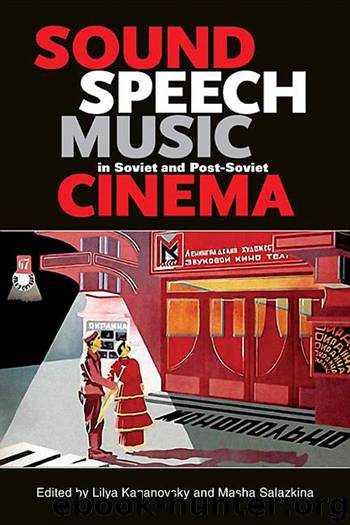Sound, Speech, Music in Soviet and Post-Soviet Cinema by Salazkina Masha Kaganovsky Lilya & Masha Salazkina

Author:Salazkina, Masha, Kaganovsky, Lilya & Masha Salazkina
Language: eng
Format: epub
Publisher: Indiana University Press
Published: 2014-03-14T16:00:00+00:00
Recording Technique and Style
The new technological possibilities of the second sound revolution of the 1950s also meant innovations for the voice. The advent of stereo sound did not affect the location of the voice and other spatial effects exclusively. Stereo sound required directional microphones and the placement of the microphones behind the actors; otherwise, there would be distortion.28 The proximity of the microphone to the mouth meant that the signal became clearer (thus the microphone helped weak voices attain more volume) and background noises such as breathing, voice breaks, slight hoarseness, and spit were “caught” and played back, intensifying the level of realism, as well as the feeling of intimate proximity.
Sound-on-film technology did not permit tones that were either too loud or too quiet, and the differences between cries and whispers had to be avoided. New microphones and the process of recording on magnetic tape had introduced a new dimension especially for soft voices. New resonance quality permitted a wider range of contrasting volume and intensity of sounds, voices were recorded separately with the single adjustment of each channel, and noises were transmitted through several speakers.29 It was now possible to move freely between whispers (of about thirty decibels) and loud voices (about a hundred decibels), so that actors standing next to each other no longer had to speak equally loudly. Quiet voices, low voices, and whispers were made technically possible.
In the 1930s, certain frequencies could not be faithfully reproduced; the lower frequencies of voices were especially problematic, resulting in incomprehensible dialogue. It was considered a special mastery for sound technicians to single out the voices clearly from the background and to isolate noise. In the 1950s, sound clarity had been achieved, which meant that sound could be “contaminated.” Voices could sound deeper, and the indistinctness was no longer considered a “disturbance.” The second contamination came later with rock music that rejected the clear metallic sound and allowed for hoarseness and sonic pollution.
Film historians believe that the new realism of sound and voice in feature films was influenced by the contemporaneous development of documentary filmmaking. The appearance of the small synchronized camera and the Nagra equipment for the film industry gave a new impulse to documentary films with direct sound. Direct cinema and cinema verité tolerated indistinctness, unidentifiable noises, and the simultaneity of overlapping voices. Protagonists of documentary films had untrained voices; they spoke with pauses, coughs, hiccups, and stutters; in unfinished, broken sentences, with incorrect pronunciation; they brought with them the peculiarity of intonation, and that vocal aesthetic was also adopted for feature films. The mumbling of real people undermined the transfer of meaning through words—meaning now shifted to intonation, sound, and mood.
Neorealist films and the films of the various new waves utilized the same stylistic devices: streets and original interiors instead of studios; natural rather than artificial lighting; black-and-white film in contrast to Technicolor; long, seemingly uncomposed shots, loose dramaturgy, and indistinctly speaking amateur actors. This aesthetic meant a renunciation of written dialogue, acting, and the professionally trained voice.
Download
This site does not store any files on its server. We only index and link to content provided by other sites. Please contact the content providers to delete copyright contents if any and email us, we'll remove relevant links or contents immediately.
The Goal (Off-Campus #4) by Elle Kennedy(13543)
Kathy Andrews Collection by Kathy Andrews(11730)
Diary of a Player by Brad Paisley(7487)
What Does This Button Do? by Bruce Dickinson(6134)
Assassin’s Fate by Robin Hobb(6128)
Big Little Lies by Liane Moriarty(5702)
Altered Sensations by David Pantalony(5045)
Pale Blue Dot by Carl Sagan(4912)
Sticky Fingers by Joe Hagan(4101)
The Death of the Heart by Elizabeth Bowen(3551)
The Heroin Diaries by Nikki Sixx(3494)
Beneath These Shadows by Meghan March(3262)
Confessions of a Video Vixen by Karrine Steffans(3245)
How Music Works by David Byrne(3187)
The Help by Kathryn Stockett(3083)
Jam by Jam (epub)(3024)
Harry Potter 4 - Harry Potter and The Goblet of Fire by J.K.Rowling(2990)
Strange Fascination: David Bowie: The Definitive Story by David Buckley(2798)
Petty: The Biography by Warren Zanes(2697)
